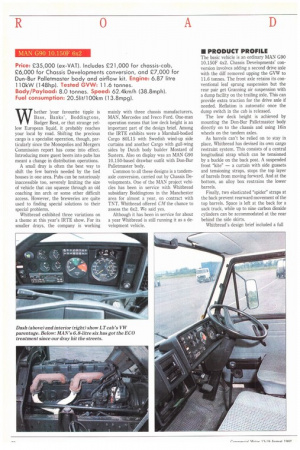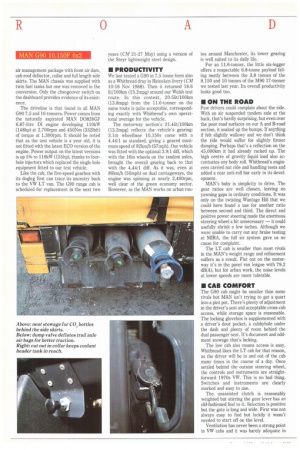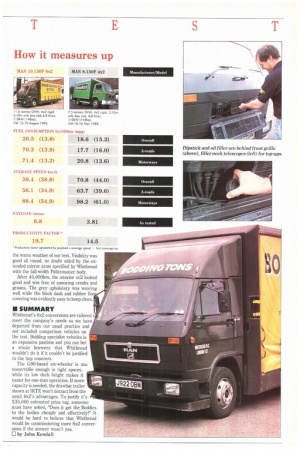W hether !your favourite tipple is Bass, Banks', Boddingtons, Badger Best,
Page 34

Page 36

Page 37

If you've noticed an error in this article please click here to report it so we can fix it.
or that strange yellow European liquid, it probably reaches your local by road. Shifting the precious cargo is a specialist operation, though, particularly since the Monopolies and Mergers Commission report has come into effect. Introducing more guest beers into pubs has meant a change in distribution operations.
A small dray is often the best way to shift the few barrels needed by the tied houses in one area. Pubs can be notoriously inaccessible too, severely limiting the size of vehicle that can squeeze through an old coaching inn arch or some other difficult access. However, the breweries are quite used to finding special solutions to their special problems.
Whitbread exhibited three variations on a theme at this year's IRTE show. For its smaller drays, the company is working mainly with three chassis manufacturers, MAN, Mercedes and Iveco Ford. One-man operation means that low deck height is an important part of the design brief. Among the IRTE exhibits were a Marshall-bodied Cargo 80L15 with Swedish wind-up side curtains and another Cargo with gull-wing sides by Dutch body builder Mostard of Sustern. Also on display was an MAN G90 10.150-based drawbar outfit with Don-Bur Palletmaster body.
Common to all these designs is a tandemaxle conversion, carried out by Chassis Developments. One of the MAN project vehicles has been in service with Whitbread subsidiary Boddingtons in the Manchester area for almost a year, on contract with TNT. Whitbread offered CM the chance to assess the 6x2. We said yes.
Although it has been in service for about a year Whitbread is still running it as a development vehicle.
• PRODUCT PROFILE
The basic vehicle is an ordinary MAN G90 10.150F 4x2. Chassis Developments' conversion involves adding a second drive axle with the diff removed upping the GVW to 11.6 tonnes. The front axle retains its conventional leaf sprung suspension but the rear pair get Granning air suspension with a dump facility on the trailing axle. This can provide extra traction for the drive axle if needed. Reflation is automatic once the dump switch in the cab is released.
The low deck height is achieved by mounting the Don-Bur Palletmaster body directly on to the chassis and using 16in wheels on the tandem axles.
As barrels can't be relied on to stay in place, Whitbread has devised its own cargo restraint system. This consists of a central longitudinal strap which can be tensioned by a buckle on the back post. A suspended front "kite" — a curtain with side gussets and tensioning straps, stops the top layer of barrels from moving forward. And at the bottom, an alloy box restrains the lower barrels.
Finally, two elasticated "spider" straps at the back prevent rearward movement of the top barrels. Space is left at the back for a sack truck, while up to nine carbon dioxide cylinders can be accommodated at the rear behind the side skirts.
Whitbread's design brief included a full air management package with front air dam, cab roof deflector, collar and full length side skirts. The MAN chassis was supplied with twin fuel tanks but one was removed in the conversion. Only the changeover switch on the dashboard provides evidence of its existence.
The driveline is that found in all MAN G90 7.5 and 10-tonners. Power comes from the naturally aspirated MAN D0826GF 6,87-litre DI engine developing 110kW (148hp) at 2,700rpm and 450Nm (3321bft) of torque at 1,300rpm. It should be noted that as the test vehicle is a year old, it is not fitted with the latest ECO version of the engine. Power output on the latest versions is up 5% to 116kW (155hp), thanks to fourhole injectors which replaced the single hole equipment fitted to our test vehicle.
Like the cab, the five-speed gearbox with its dogleg first can trace its ancestry back to the VW LT van. The G90 range cab is scheduled for replacement in the next two
years (CM 21-27 May) using a version of the Steyr lightweight steel design.
• PRODUCTIVITY
We last tested a G90 in 7.5 tonne form also as a Whitbread dray in Heineken livery (CM 10-16 Nov 1988). Then it returned 18.6 lit/100km (15.2mpg) around our Welsh test route. In this context, 20.51it/1001un (13.8mpg) from the 11.6-tonner on the same route is quite acceptable, corresponding exactly with Whitbread's own operational average for the vehicle.
The motorway section's 21.41it/1001cm (13.2mpg) reflects the vehicle's gearing: 3.1m wheelbase 10.150s come with a 4.44:1 as standard, giving a geared maximum speed of 92km/h (57mph). Our vehicle was fitted with the optional 3,9:1 diff, which with the 16in wheels on the tandem axles, brought the overall gearing back to that with the 4.44:1 diff. As it was, even at 80krn/h (50mph) on dual carriageways, the engine was spinning at nearly 2,400rpm, well clear of the green economy sector. However, as the MAN works on urban rou
tes around Manchester, its lower gearing is well suited to its daily life.
For an 11.6-tonner, the little six-legger offers a respectable 6.8-tonne payload falling neatly between the 3.8 tonnes of the 8.150 and 10 tonnes of the M90 17-tonner we tested last year. Its overall productivity looks good too.
• ON THE ROAD
Few drivers could complain about the ride. With an air suspended tandem axle at the back, that's hardly surprising, but even over the poor road surfaces on our A and B-road section, it soaked up the bumps. If anything if felt slightly wallowy and we don't think the ride would suffer for slightly firmer damping. Perhaps that's a reflection on the 45,000km it had already racked up. The high centre of gravity liquid load also accentuates any body roll. Whitbread's engineers carried out ride and handling tests and added a rear anti-roll bar early in its development.
MAN's baby is simplicity to drive. The gear ratios are well chosen, leaving no yawning gaps in ordinary conditions. It was only on the twisting Wantage Hill that we could have found a use for another ratio between second and third. The direct and positive power steering made the enormous steering wheel a bit unnecessary — it could usefully shrink a few inches. Although we were unable to carry out any brake testing at MIRA, the full air system gave us no cause for complaint.
The LT cab is smaller than most rivals in the MAN's weight range and refinement suffers as a result. Flat out on the motorway it's in the panel van league with 79,2 dB(A), but for urban work, the noise levels at lower speeds are more tolerable.
• CAB COMFORT
The G90 cab might be smaller than some rivals but MAN isn't trying to get a quart into a pint pot. There's plenty of adjustment in the driver's seat and acceptable cross-cab access, while storage space is reasonable. The locking glovebox is supplemented with a driver's door pocket, a cubbyhole under the dash and plenty of room behind the dual passenger seat. It's document and oddment stowage that's lacking.
The low cab also means access is easy. Whitbread likes the LT cab for that reason, as the driver will be in and out of the cab many times in the course of a day. Once settled behind the outsize steering wheel, the controls and instruments are straightforward 1970s VW. This is no bad thing. Switches and instruments are clearly marked and easy to use.
The unassisted clutch is reasonably weighted but stirring the gear lever has an old-fashioned feel to it. Selection is positive but the gate is long and wide. First was not always easy to find but luckily it wasn't needed to start off on the level.
Ventilation has never been a strong point in VW cabs and it was barely adequate in the warm weather of our test. Visibility was good all round, no doubt aided by the extended mirror arms specified by Whitbread with the full-width Palletmaster body.
After 45,000km, the interior still looked good and was free of annoying creaks and groans. The grey upholstery was wearing well while the black dash and rubber floo covering was evidently easy to keep clean.
• SUMMARY
Whitbread's 6x2 conversions are tailored t meet the company's needs so we have departed from our usual practice and not included comparison vehicles on the test. Building specialist vehicles is an expensive pastime and you can bet a whole brewery that Whitbread wouldn't do it if it couldn't be justified to the hop counters.
The G90-based six-wheeler is manoeuvrable enough in tight spaces, while its low deck height makes it easier for one-man operation. If more capacity is needed, the drawbar trailer shown at IRTE won't detract from the small 6x2's advantages. To justify it's £35,000 estimated price tag, someone must have asked, "Does it get the Boddies to the bodies cheaply and effectively?" It would be hard to believe that Whitbread would be commissioning more 6x2 conversions if the answer wasn't yes.
El by John Kendall












































































